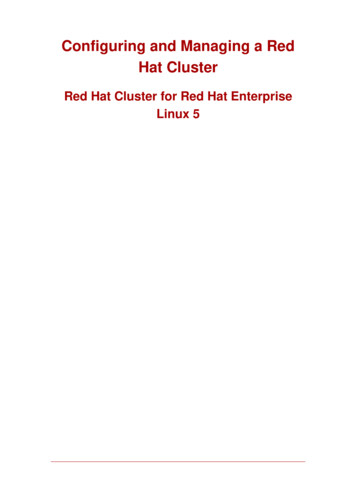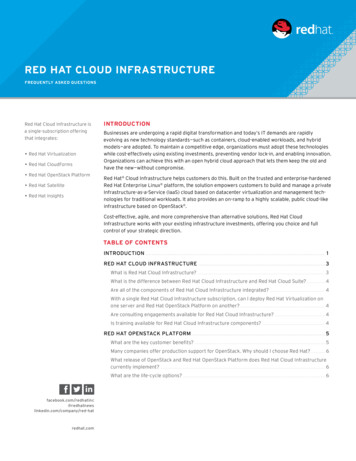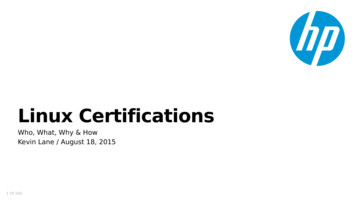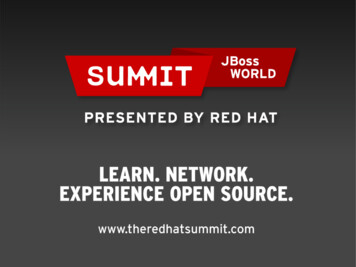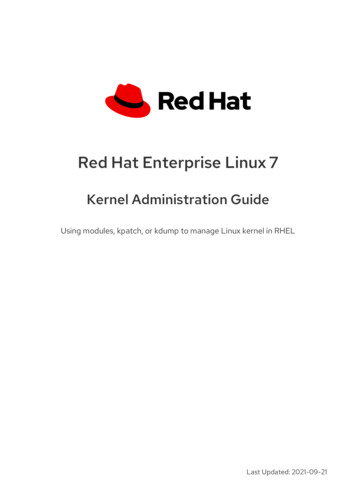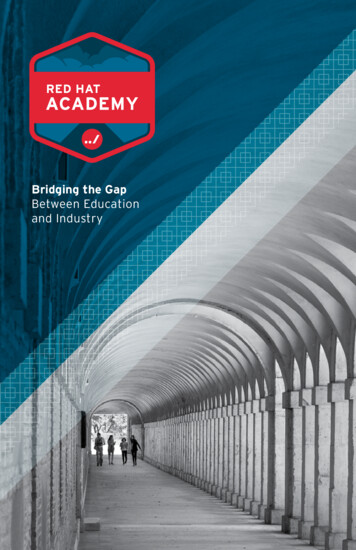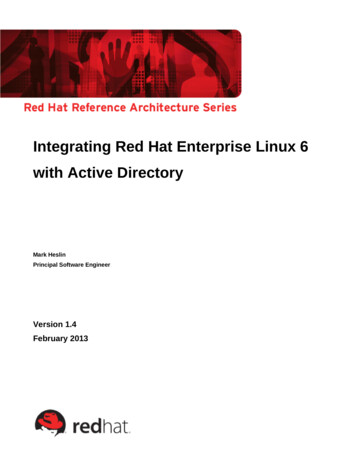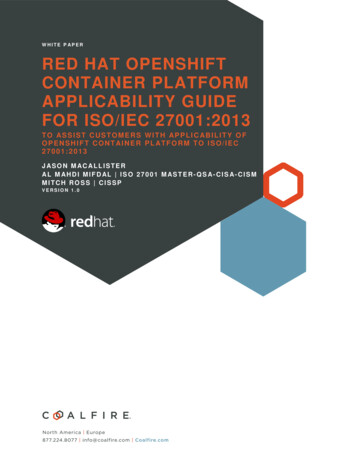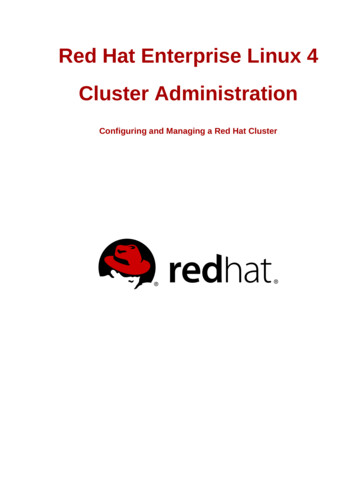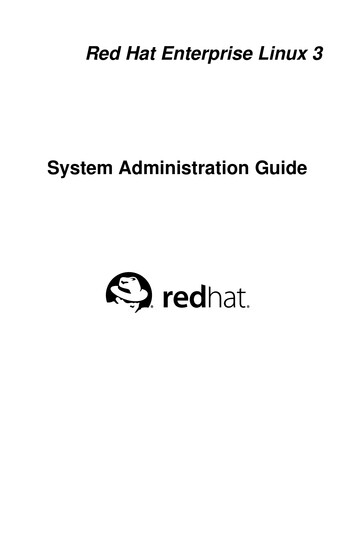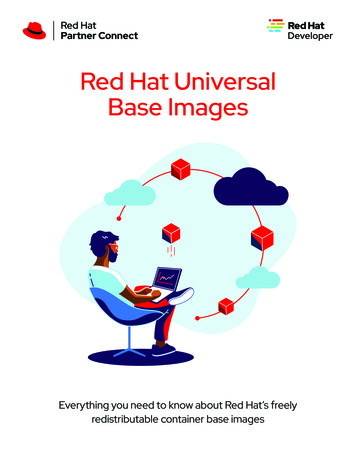
Transcription
Red Hat UniversalBase ImagesEverything you need to know about Red Hat’s freelyredistributable container base images
Contents05Foreword06Part 1 — Introduction to Red Hat Universal Base Images1.1. IntroductionWhat you will learn from reading this book1.2. The motivation behind Red Hat Universal Base ImagesWhat is a container base image?Does it matter what is in the container base image?Subscription requirement for using Red Hat Enterprise Linux1.3. Introducing Red Hat Universal Base ImagesWhat’s in UBI?Additional RPMs compatible with UBI1.4. Future enhancements to UBI17Part 2 — Why choosing a source of base images is a strategic decision2.1. Standard operating environments and containers2.2. The impact of not standardizing container base imagesThe version explosion: how many different versions am I running?2.3. Responsibility for maintaining the software stack inside of container images2.4. Considerations for choosing a source of base images2.5. The benefits of UBI as an SOE24Part 3 — UBI support and licensing3.1. UBI life cycle and updatesUBI 8UBI 73.2. UBI container image and RPM update policy3.3. The limits of container compatibility and supportabilityCompatibility across different Red Hat versions3.4. UBI support informationRed Hat support for mixed container image and container host OS versionsRecommendations based on the container compatibility matrixRed Hat support documents3.5. UBI licensing and redistributionRed Hat Universal Base Images Contents
32Part 4 — Working with Red Hat4.1. Getting support from Red Hat4.2. Getting a no-cost subscription for access to Red Hat resources4.3. Requesting UBI enhancements4.4. The Red Hat Ecosystem CatalogRed Hat Ecosystem Catalog for Red Hat published UBI imagesRed Hat Ecosystem Catalog for Red Hat certified partner products4.5. Container health index4.6. Red Hat Vulnerability Scanner Certification4.7. Partnering with Red HatBuild with Red HatListing your certified applications in the Red Hat Ecosystem CatalogListing your certified applications in the Red Hat Marketplace4.8. Red Hat Container Certification40Part 5 — Red Hat and open container tools5.1. UBI works with any OCI-compliant container tools (including Docker)5.2. Docker on Red Hat systemsDocker Inc.’s Docker-ce or Docker-ee can be installed on Red Hat Enterprise LinuxUsing docker CLI commands with Podman and Buildah5.3. The motivation for open container tools5.4. Overview of Red Hat’s open container toolsPodman: A tool for managing containers and podsBuildah: A tool for building container imagesSkopeo: A tool for working with container registries and imagesUdica: A tool that generates SELinux policies for containersCRIU: Checkpoint and restore containers in userspaceCRI-O: A lightweight container runtime for Kubernetes5.5. Getting started with open container toolsContainer tools on Red Hat Enterprise Linux 8Container tools on Red Hat Enterprise Linux 7Other Linux distributionsContainer tool tutorialsRed Hat Universal Base Images Contents
52Part 6 — Working with UBI6.1. Where to find UBI container imagesRed Hat container registriesWorking with Red Hat’s authenticated container registry6.2. Guided online tutorials with UBI6.3. Using UBI on Windows, macOS, and Linux with Docker6.4. Using UBI on Red Hat Enterprise Linux and systems with Podman6.5. Choosing between UBI base imagesThe UBI minimal imageThe multi-service UBI image6.6. Adding software to UBI imagesUBI and Red Hat Enterprise Linux RepositoriesAdding packages to UBI 8Adding packages to UBI 773For more informationRed Hat Universal Base Images Contents
ForewordContainers offer developers an easy-to-use mechanism for building an applicationwith all of its operating system dependencies encapsulated in a light-weightimage format. But, these dependencies still have the security, performance, andlife-cycle requirements of any Linux distribution.Red Hat developed and released Red Hat Universal Base Images (UBI) to givedevelopers access to the world’s leading Enterprise Linux while working withcontainerized applications. UBI makes it easy for developers to get access tohigh-quality application dependencies, and also makes it easy for operators todeploy on Red Hat Enterprise Linux and Red Hat OpenShift when they wanthigh-quality support in production.Not only does UBI offer the classic value that comes from Red Hat Enterprise Linuxas a Linux operating system, it also has its own roadmap of features, including UBImicro to deliver tiny container images, the container health index to verify security,and world-class XML data for scanning the contents of an image to verify Red Hatis patching it regularly. Plus, you don’t need to be a Red Hat customer to use it.Keep your eyes out for other new features designed to help you build small, nimble,and secure applications with UBI.— Scott McCarty: Principal Product Manager, Containers, Red HatRed Hat Universal Base Images 5
Part 1Introduction to Red Hat UniversalBase Images1.1. IntroductionContainers have provided great benefits for developing and operating applications andmicroservices. Application code, language runtimes, and operating system (OS) components are merged into a single delivery mechanism, allowing an application to run in production with the identical runtime components with which it was developed. Testing andsupport are streamlined and many of the situations where code doesn’t work correctly ona system other than the developer’s are eliminated.To satisfy application runtime dependencies, containers bundle a number of the components from a traditional OS. The foundation for building applications in containersis a container base image. A container base image typically includes a number of preinstalled packages and additional packages that can be easily installed with a packagemanager like YUM or DNF. The base images and their packages are essentially a LinuxOS distribution that has been stripped down to the bare minimum.Selecting, operating, and maintaining operating systems has long been the responsibilityof IT. Through experience, IT organizations have learned that high standards for operating systems are necessary to maintain an environment that is stable, reliable, and secure.To reduce complexity and operational drag, IT organizations develop Standard OperatingEnvironments (SOEs) that include an identical OS base image for all of the machinesthey operate. For updates, security advisories, and help when things go wrong, ITorganizations maintain a relationship with an OS vendor that provides support. Reliability,stability, and high-quality, long-term support is why many IT organizations choose to runRed Hat Enterprise Linux.Container base imagesare essentially Linuxdistributions that arestripped down to the bareminimum. They includea subset of files from/bin, /etc, /lib, and/usr that are necessaryfor a typical application torun on Linux.It’s important to consider that the full stack on which a containerized applicationdepends includes the host system’s OS as well as the OS components inside the container. With containers, the control over what OS components run inside of the containerare shifted from IT to the container developer.Just as a mature IT organization would exercise control over which OS versions run ontheir hardware, they need to track what container base images are used to run businesscritical applications on their hardware. IT usually still has the responsibility for makingsure the application runs reliably.Containers are an extension of the OS environment. Therefore, containers should betreated as part of a SOE. This is critical when something goes wrong and support isneeded that only an OS vendor can provide.To meet their customer’s requirements for support, developers and ISVs can base theircontainer images on Red Hat Enterprise Linux. However, a subscription is required touse Red Hat Enterprise Linux. So for consumers of their software that don’t have, or areunwilling to purchase a Red Hat subscription, developers need to build their applicationson a different base image. To meet both demands, developers would need to build andsupport their applications on multiple container base images.Red Hat Universal Base Images 6Developers, rather thanIT, typically choose theOS components that runinside of containers.
Part 1 — Introduction to Red Hat Universal Base ImagesRed Hat solved this challenge by creating Red Hat Universal Base Images (UBI).UBI is a freely distributable subset of Red Hat Enterprise Linux to satisfy the runtimedependencies of container-based applications. Anyone can use UBI without a subscription. No registration with Red Hat is required. UBI retains the most desirable aspects ofRed Hat Enterprise Linux, namely long-term updates and support. Updates to UBIand Red Hat Enterprise Linux share the same rigorous attention to security, reliability,compatibility, and performance.Organizations that want support can get support from Red Hat for the full stack, fromRed Hat Enterprise Linux running on the host system up to the UBI components runninginside the container. Since UBI can be used without a subscription, the same containerimage can be used both for organizations that want support and those that don’t.UBI is a good choice for any software project, including free open source projects, thatneed a source of high-quality container images and packages with long-term updatesand stability.What you will learn from reading this bookThis book contains information to help you understand and get started with UBI,including: How you can use freely available container images that build on the long termsupport, commitment to quality, security, reliability, and performance of Red HatEnterprise Linux. Why choosing a base container image is a strategic decision: How container base images are a key part of your standard operatingenvironment. Considerations for choosing base images — why what’s in your base image and thenumber of different base images in your environment matter. How the decisions you make about base images and packages you add toyour containers impacts the support options available to those who run yourcontainers. About the update and support life cycle for UBI: How often and for how long UBI images and packages will be updated. Support options available from Red Hat for UBI. About the Red Hat Ecosystem Catalog, a source for finding container images andother software from Red Hat and its partners. Developers and ISVs can learn howtheir applications can be listed in the Red Hat Ecosystem Catalog to make it easy forRed Hat customers to find. As a developer or ISV, learn how your users can run your UBI-based images on theirplatform of choice and what options they have for full support by Red Hat.Red Hat Universal Base Images 7
Part 1 — Introduction to Red Hat Universal Base ImagesWhat you will also learn about working with UBI: Which types of UBI images are available and how to choose between them. How to find the available UBI images, including language and other runtime imagesthat are ready for you to add your code. Where to find additional packages to use with UBI images. How you can use additional images and packages available from Red HatEnterprise Linux and how that affects redistribution. How Red Hat partners can use Red Hat Enterprise Linux content in theirredistributable images. An overview of the OCI-compliant container tools that Red Hat is leading thedevelopment of in open communities.Who should read this book?Developers and those packaging software in containersshould read Parts 1, 3, and 6 to learn how to best use UBI intheir projects. Part 5 is recommended to learn about container tools that offer a number of advantages over commonlyused tools.Software partners (Independent Software Vendors,Systems Integrators, etc.) should read Parts 1, 2, 3, and 4 tounderstand the benefits of using UBI in their products, andthe value proposition of working with Red Hat and becoming aRed Hat Partner.IT architects and managers should read Parts 1, 2, 3, and 5to understand the role container base images play in an ITlandscape and how they relate to standard operating environments. Considerations for choosing a source of base imagesare covered in Part 2.Security operations professionals should read Parts 1, 2,and 3 to understand the role of container base images in anIT landscape and their life cycle. Part 4 contains additionalsecurity related information on the Red Hat container healthindex and container vulnerability scanning.Red Hat Universal Base Images 8
Part 1 — Introduction to Red Hat Universal Base Images1.2. The motivation behind Red Hat Universal Base ImagesWhat is a container base image?Linux containers offer a lighter-weight version of the Linux OS that allows an applicationand its dependencies, like OS and language libraries, to be packaged into an isolatedportable environment that can easily be distributed. The lighter-weight aspect is thata single Linux kernel is shared between the host system and any containers running onthat host. The isolation is in part because each container has its own virtual filesystem.The files available inside a container are a result of packaging those files into one ormore container images.To run almost anything inside a container there needs to be a number of OS-dependentfiles inside the containers: Dynamically loadable libraries in /lib and /usr/lib, like the C runtime, math,threading, and cryptography libraries. OS configuration files in /etc, including network and timezone information. Miscellaneous shared OS files in /usr/share. Writable space for various temporary and transient files in /tmp and /var.You might not be aware that your application depends on all of these files. Unless anapplication is a statically linked binary, it uses a number of dynamically loaded libraries,starting with the C runtime library (often glibc) that provides an interface to the Linuxkernel’s system calls. Even if your application is written in Java or Python, rather than C,the Java Virtual Machine and Python interpreter that runs your code uses the C runtimelibrary to perform system calls and interact with the system.Most libraries, including the C runtime library, are built as shared objects to save diskspace and memory. Rather than making a copy of them in each executable program, theyare dynamically loaded at run time. The library .so files need to be available in the filesystem when the executable program runs.The files that make up the OS are often referred to as the userland. Everything that runsabove the kernel is considered the user space. If it helps to remember userland, think of/usr (pronounced user) where the bulk of the OS files reside. You could say that a Linuxdistribution is essentially a Linux kernel and a userland packaged in some easily consumable form.When creating a container, to avoid populating all of the userland files from scratch, acontainer base image is the most common starting point. Container base images are thefiles from a Linux distribution that are stripped down to the bare minimum to supportrunning an application. Figure 1 compares container base image components to a Linuxdistribution.Red Hat Universal Base Images 9
Part 1 — Introduction to Red Hat Universal Base ImagesLinux distributionContainer base imageApplicationsLanguage runtimes Java, Go, Python, .Language runtimes Java, Go, Python, .Executables - bash, cp,tar, .Executables - bash, cp,tar, .Libraries - C runtime,math, crypto, .Libraries - C runtime,math, crypto, .Package management, yumPackage management, yumLinux kernelFigure 1. Linux distribution and container base image componentsDoes it matter what is in the container base image?Many container images use a base image that is a stripped down version of an existingLinux distribution like Debian, Alpine, Fedora, or CentOS Streams. Most of these baseimages are maintained by communities. They lack the support that is a critical requirement for many organizations when choosing an OS to run.For efficiency of moving container images over the network, and to a lesser degreedisk space, there is a focus on minimal container size as a primary factor in choosingcontainer base images. While container image size is an easy thing to measure, there aremore important factors to consider.There is a fallacy that the traditional Linux distribution and standard operating environments don’t matter anymore with containers. While containers are Linux distributionsstripped down to their bare essentials, they are still an operating system and the qualityof a container matters just as much as that of the host operating system.Software that runs in containers still has a life cycle that needs to be maintained.The need for updates to make sure all software is free of vulnerabilities is just as important as with traditional deployments.It might be tempting to overlook the bits in container images and think it doesn’t matterwhere they come from. What is in container images matters, especially to the organizations that have critical software running in containers. In the early days of containerdeployments, many organizations didn’t have enough experience to realize each container they run becomes another part of their IT landscape that they must maintain. In asense, the choice of what OS components an organization runs inside container imagesis delegated to the developer of that containerized application.Red Hat Universal Base Images 10
Part 1 — Introduction to Red Hat Universal Base ImagesThe concerns for the contents of container images are similar to choosing an OS ormiddleware, namely:Provenance — Do you know the source of the bits in the containerimage? Are all of the bits actually from the organization you intended itto be?Authenticity — Can the contents of the container image be verified?Has anything been modified by someone other than the originalsource?Security — Can you verify whether the code running in the container isfree of any known vulnerabilities? Is the default configuration secure,especially for enterprise use?Quality and reliability — What testing is performed to make sure thecode works correctly and performs well? Updates frequently introduceregressions and can create new vulnerabilities. What testing is donewhen updates are applied?Performance — Have there been tests to determine how well the software performs under load on enterprise-grade hardware?Life cycle — How long will the software in the container be maintained?How long will updates be released to fix bugs and vulnerabilities?Source code availability — Do you have access to the exact version ofthe code that was used to produce the container image?Licensing — Is all of the software actually open source with appropriatelicenses that are compatible with your uses? Will you be able to fulfill therequirements for making the source code available for any GPL-licensedsoftware in the base images you use in distributing your software?As a software developer, many of the above concerns might not seem very important.However, for consumers of your software, especially enterprises with critical businessoperations depending on software, these concerns are all important. It is because ofthese concerns that organizations chose to use software with support from Red Hatlike Red Hat Enterprise Linux and Red Hat Middleware. The support Red Hat offers onproducts is possible due to the size of Red Hat’s staff to perform engineering, qualityassurance, performance testing, security assessments, documentation, releases, andcustomer support.Red Hat Universal Base Images 11
Part 1 — Introduction to Red Hat Universal Base ImagesSubscription requirement for using Red Hat Enterprise LinuxRed Hat offered certified container images starting with Red Hat Enterprise Linux 7.Given that organizations use Red Hat Enterprise Linux so they can get support, why notjust use one of these as a base image? The use of Red Hat Enterprise Linux is governedthrough subscriptions, and some end users might not have or be willing to obtain Red Hatsubscriptions. As a result, developers were faced with a few choices that have drawbacks:1. Base containers on freely available software like CentOS or CentOS Streams.The drawback is that consumers of their software that want support have no optionfor support of the OS components inside the container. For community-basedsoftware projects, this is the typical choice.2. Base containers on Red Hat Enterprise Linux. While this option gives those that wantit the option of support, they need to require that all customers have or obtain aRed Hat Enterprise Linux subscription.3. Build two sets of container images, one based on Red Hat Enterprise Linux and theother based on freely available unsupported software. For some developers and ISVsthis is the most viable option even though it increases the amount of work to build,test and distribute software.It’s also worth noting that access to Red Hat Enterprise Linux repositories and registriesis controlled by authenticating through Red Hat Subscription Management. This canadd complexity to automated CI/CD processes that involve Red Hat Enterprise Linuxcontainers, and has led to some organizations using freely available base images, likeCentOS, for some automated tasks, even though they had Red Hat Enterprise Linuxsubscriptions.1.3. Introducing Red Hat Universal Base ImagesIn May of 2019, Red Hat announced Red Hat Universal Base Images (UBI) to provideno-cost, certified, and up-to-date enterprise-grade container base images.UBI provides common application dependencies to form an ideal basis for developing and delivering container-based applications. Built from a subset of Red HatEnterprise Linux, UBI is freely redistributable. No subscription or any relationshipwith Red Hat is required to use UBI.UBI retains a number of the most important Red Hat Enterprise Linux attributes: Support — When run on Red Hat platforms like Red Hat Enterprise Linux or Red HatOpenShift, UBI is fully supported by Red Hat. This gives organizations that requirethe assurances of having access to support all of the options that are available fromRed Hat. 10 year life cycle — As a subset of Red Hat Enterprise Linux, UBI shares the life cycleof the Red Hat Enterprise Linux version it is based on, with updates and support forup to 10 years. Same release cadence — UBI updates and releases are concurrent with Red HatEnterprise Linux releases.Red Hat Universal Base Images 12UBI is free to downloadand redistribute.No subscription, login,or even registrationis required.
Part 1 — Introduction to Red Hat Universal Base ImagesSince container images based on UBI are freely redistributable, UBI is also ideal for opensource community projects. The same UBI-based container image can be used for free,open source applications, or enterprise deployments with full support. By using a UBIbased image, as opposed to something like CentOS, Fedora, or Debian, the organizationthat runs the application, rather than the developer of the software, gets to choose theirsupport options.What’s in UBI?UBI 8 is a subset of Red Hat Enterprise Linux 8. Likewise, UBI 7 is a subset of Red HatEnterprise Linux 7. The UBI images are Open Container Initiative (OCI)-compliant Linuxcontainer images that can be run on any OCI-compliant container runtime like Linux withDocker or Podman, Kubernetes with containerd or CRI-O, or Windows or macOS withDocker Desktop.UBI base OS container imagesThe foundational component for UBI is a set of base OS container images. To addressdifferent use case requirements, there are three different variations of the UBI base OScontainer images: UBI Platform image is designed to address the needs of 80% of typical applicationsthat run on Red Hat Enterprise Linux. In terms of size and pre-installed packages, thisis the middle of the road image that is generally the best starting point. For adding,updating, and removing packages it includes the full YUM package managementsystem that you’d find on Red Hat Enterprise Linux. All locales are present to addressinternationalization and localization. UBI Minimal image is for applications that contain their own dependencies and wanta smaller container image size. Only a minimal set of packages and the English (en)locale are pre-installed. UBI Multi-service image is designed for running multiple processes inside a singlecontainer that are managed by systemd. By design, containers generally run a singleprocess. When that process exits, the container exits. The multi-service image runssystemd so that multiple processes, such as a database and a web server, can be runand restarted within a single container.APP 0APP 0Microdnf coreutilsYUM @base/usr/sbin/initGlibc (en local)Glibc (full locales)Glibc (full alubi7/ubi-minimalFigure 2. UBI base OS image optionsRed Hat Universal Base Images 13ubi8/ubiubi7/ubiAPP 0APP 1ubi8/ubi-initubi7/ubi-initRed Hat softwarepartners that join Red HatPartner Connect canalso redistribute non-UBIand non-kernel Red HatEnterprise Linux packagesthrough Red HatContainer Certification.See section 4.7.
Part 1 — Introduction to Red Hat Universal Base ImagesUBI pre-built runtime imagesUBI includes pre-built container images with language runtimes including Node.js,OpenJDK, Perl, PHP, Python, and Ruby along with servers like Apache HTTPD andNginx. These are built on top of the UBI platform OS base image. For UBI 8, theseruntime images are based on the application streams from Red Hat Enterprise Linux 8.For UBI 7, these runtime images are based on the Red Hat Software Collection imagesthat are available for Red Hat Enterprise Linux 7.Some of the container images provided for UBI 8 as of early 2021 are listed in thetable below.Table 1. Language and server runtime images available in UBI 8UBI 8 Image NamePurposeubi8/dotnet-21ubi8/dotnet-31Building and running .NET Core i8/dotnet-31-runtimeubi8/dotnet-50-runtimeRunning .NET Core applications (runtime only)ubi8/go-toolsetBuilding and running Go language s-14Building and running Node.js applicationsub8/nginx-118Running, proxying, or accelerating web-based applicationsusing Nginxubi8/openjdk-8ubi8/openjdk-11Building and running Java applicationsubi8/perl-526ubi8/perl-530Building and running Perl applications includes Apache HTTPD2.4 and mod perlubi8/php-72ubi8/php-73ubi8/php-74Building and running web-based PHP applications includesApache HTTPD ing and running Python ilding and running web-based Ruby applicationsubi8/s2i-baseubi8/s2i-coreBuilding source code into imagesIncludes GCC, make, git, and essential librariesYou can find the latest UBI 8 container images in the container image section of theRed Hat Ecosystem Catalog.Red Hat Universal Base Images 14
Part 1 — Introduction to Red Hat Universal Base ImagesSome of the container images provided for UBI 7 as of early 2021 are listed in thetable below.Table 2. Language and server runtime images available in UBI 7UBI 7 Image NamePurposeubi7/go-toolsetBuilding and running Go language applicationsubi7/nodejs-10ubi7/nodejs-12Building and runningNode.js applicationsubi7/openjdk-8ubi7/openjdk-11Building and running Java applicationsubi7/php-73Building and running web-based PHP applications includesApache HTTPD 2.4ubi7/python-27ubi7/python-38Building and running Python applicationsubi7/ruby-25ubi7/ruby-26Building and running web-based Ruby applicationsubi7/s2i-baseubi7/s2i-coreBuilding source code into imagesIncludes GCC, make, git, and essential librariesYou can find the latest UBI 7 container images in the container image section of theRed Hat Ecosystem Catalog.UBI RPM packages and YUM repositoriesTo add additional software to UBI-based container images, RPM packages are available inUBI YUM repositories. The RPMs available in UBI are a subset of Red Hat Enterprise LinuxRPMs. This subset was chosen to satisfy common application dependencies. The RPMscan be installed with the YUM package management system in the UBI platform andmulti-service images. For the minimal UBI image, use microdnf instead of yum.The UBI RPMs and repositories provide a source of packages, maintained by Red Hat,that you can add to the UBI-based container images that you develop and distribute.The UBI YUM repositories do not require any authentication or subscriptions.The RPMs available in UBI are the same as their counterparts in Red Hat Enterprise Linux.They have the same life cycle and receive the same updates under the normal Red HatEnterprise Linux life cycle. The advantage of using UBI RPMs is knowing that if a vulnerability or quality issue is found that is fixed by Red Hat Enterprise Linux, the UBI RPMsalso receive the same update.Red Hat Universal Base Images 15
Part 1 — Introduction to Red Hat Universal Base ImagesAdditional RPMs compatible with UBIThe UBI RPM repositories contain a much smaller number of RPMs compared to what isavailable in Red Hat Enterprise Linux. This is understandable as Red Hat Enterprise Linuxcontains a large amount of packages for interactive and graphical applications that aren’tuseful in a container-based environment.As UBI is a subset of Red Hat Enterprise Linux, you have the option of installing anyRPMs that are built for the version of Red Hat Enterprise Linux that corresponds to yourUBI images. This includes RPMs from third-party repositories like the Extra Packagesfor Enterprise Linux (EPEL) project. For example, you can install packages from theEPEL 8 repository in your ubi8 images.Red Hat Enterprise Linux RPMs are not redistributableRPMs from Red Hat Enterprise Linux are not-redistributable as a default. If you addany RPMs from Red Hat Enterprise
5.1. UBI works with any OCI-compliant container tools (including Docker) 5.2. Docker on Red Hat systems Docker Inc.'s Docker-ce or Docker-ee can be installed on Red Hat Enterprise Linux Using docker CLI commands with Podman and Buildah 5.3. The motivation for open container tools 5.4. Overview of Red Hat's open container tools
